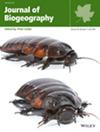A Tale of Two Tails: Untangling the Phylogeography and Demographic History of Extant Species of Mulgara (Dasycercus spp.) in the Australian Arid Zone
Abstract
Aim
Australia's arid and semi-arid zones cover about 70% of the continent, yet our understanding of the biogeography of these diverse and expansive landscapes remains limited. Mulgara (Dasycercus spp.; Marsupialia: Dasyuridae), a widely distributed mammal taxon, offers an opportunity to explore patterns of the population structure across the region, previously hampered by taxonomic confusion surrounding extant species. Here, we aimed to (1) clarify the current distribution of extant Dasycercus lineages, (2) describe the population genomic structure of the widespread brush-tailed mulgara, and (3) determine whether observed patterns of population genomic structure in brush-tailed mulgara are consistent with biogeographic breaks.
Location
Arid and semi-arid regions of Australia.
Taxon
Two species are extant; the brush-tailed mulgara (D. blythi) and the crest-tailed mulgara (D. hillieri, previously D. cristicauda).
Methods
We sampled individuals from contemporary and museum tissue collections, obtaining next-generation sequencing data for 311 individuals, retaining 4360 single-nucleotide polymorphisms (SNPs) for population genomic analysis.
Results
We found that the two extant species are clearly delineated, corresponding well to current understanding of their respective distributions. The population genomic substructure in the brush-tailed mulgara (211 samples, 2740 SNPs) aligns primarily with major drainage divisions. Inference of historical population size change indicated that all populations have likely had stable population sizes for much of the past 1000 years, although post-European colonisation declines in some populations cannot be ruled out. The Pilbara population was most differentiated from other populations and displayed a stronger pattern of isolation-by-distance. Nevertheless, observed heterozygosity was similar across each of the populations (Ho = 0.078–0.090).
Conclusions
Stable population dynamics linked to the ecology of the mulgara and their high dispersal potential likely explain consistent levels of genetic diversity across most populations, but the effects of geography, such as major drainage divisions, drive the apparent contemporary population structure. Additional targeted tissue collection in under-sampled regions is recommended to better quantify genomic diversity, structure, and genetic health across the species' full range.


 求助内容:
求助内容: 应助结果提醒方式:
应助结果提醒方式:


